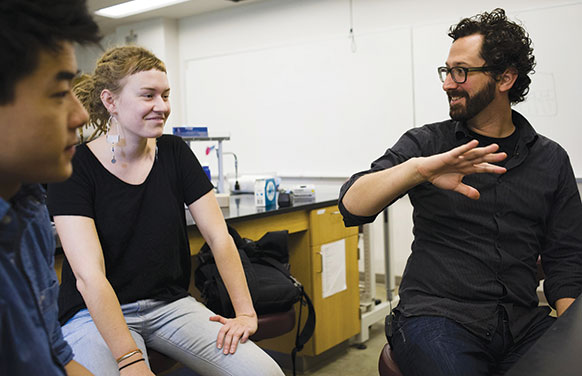
IRIS login | Reed College home Volume 94, No. 2: June 2015
Eliot Circular
Bio Prof Wins $444K Grant from NIH

THEY GOT RHYTHM. Prof. Erik Zornik and students investigate mechanisms of rhythm generation in frogs.
Photo by Leah Nash.
By Randall S. Barton
Prof. Erik Zornik [biology 2012–] has been awarded a $444,000 grant from the National Institutes of Health to support his research on mechanisms in the brain that generate rhythmic behavior—with the goal of finding new treatments for neurological disorders.
Prof. Zornik is interested in how behavioral variation is encoded in neural circuits. His research investigates a hindbrain central pattern generator that generates the courtship vocal behaviors of African clawed frogs, Xenopus laevis.
“Adults of this species exhibit a rich vocal repertoire of at least seven call types that range from rhythmically simple to temporally complex,” Zornik explains. “Xenopus vocalizations are sexually differentiated; males and females produce calls with distinct temporal characteristics that are regulated by steroid hormones during development and in adulthood. This makes their vocal behaviors an ideal subject for understanding the neural basis of behavior and behavioral plasticity.”
Because many neurological disorders involve disruptions of normal rhythms, the overarching goal of the research, he says, “is to discover novel mechanisms that underlie rhythm generation, potentially leading to novel treatments.”
The grant was awarded by the National Institute of Neurological Disorders and Stroke, which is part of the NIH.
Reed faculty members currently have 7 multiyear awards totaling $2.6 million from NIH and 22 multiyear grants and fellowships totaling $4.6 million from other funders. The other funders include 3ie, the American Council of Learned Societies, the U.S. Air Force, the Comparative and International Education Society, Fulbright, the Defense Advanced Research Projects Agency, the Environmental Protection Agency, the Ford Family Foundation, the M.J. Murdock Charitable Trust, the National Science Foundation, the National Oceanic and Atmospheric Administration, and the U.S. Department of Agriculture.

LATEST COMMENTS
steve-jobs-1976 I knew Steve Jobs when he was on the second floor of Quincy. (Fall...
Utnapishtim - 2 weeks ago
Prof. Mason Drukman [political science 1964–70] This is gold, pure gold. God bless, Prof. Drukman.
puredog - 1 month ago
virginia-davis-1965 Such a good friend & compatriot in the day of Satyricon...
czarchasm - 4 months ago
John Peara Baba 1990 John died of a broken heart from losing his mom and then his...
kodachrome - 7 months ago
Carol Sawyer 1962 Who wrote this obit? I'm writing something about Carol Sawyer...
MsLaurie Pepper - 8 months ago
William W. Wissman MAT 1969 ...and THREE sisters. Sabra, the oldest, Mary, the middle, and...
riclf - 10 months ago